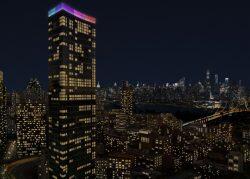An old wooden rocking chair is not a typically coveted amenity in New York luxury buildings.
But the Waldorf-Astoria‘s condo conversion is not your typical luxury project.
As part of 50,000 square feet of amenities, condo buyers will be able to repose themselves inside a library stocked by a historical preservation society founded by Jacqueline Kennedy-Onassis. A rocking chair used by John F. Kennedy will remain in the building following its renovation.
But that kind of ample amenity space — enough to build 500 apartments — belongs to an earlier era of residential development. That golden age of amenities is waning, industry experts say, as new condo projects are scaling down in size and frequency.
“The amenities race should abate,” said Peter Bazeli, a director at the development advisory firm Weitzman. “Designed well with craftsmanship, they can set the right tone of quality without needing to include a pool with a lifeguard.”
Not that swimming pools are bad — in fact, pools were the dominant trend last year among prospective buyers with an eye for amenities, according to StreetEasy — but pools favor scale, and the next round of new condo inventory will be mainly smaller projects. Developers filed just three applications for projects with more than 100 units in March, according to REBNY, down from 26 large projects in March 2022 when interest rates were still near zero.
For the so-called amenities buyer, meaning someone who is buying a condo with a heavy focus on additional facilities, that means a shrinking pool of opportunity.
“These 20,000 to 30,000 square feet of amenity spaces won’t be seen much longer,” said Kelly Mack, president of Corcoran Sunshine. “People looking for that lifestyle will need to buy now.”
Planet of the amenities
Mack’s company has helped sell two of the largest amenity packages ever built in New York.
The Waterline Square, with 1,130 units on Manhattan’s far West Side, and Extell Development’s One Manhattan Square, with 810 units on the far East Side, each planted a flag for leisure and entertainment with 100,000 square feet of amenities in otherwise out-of-the-way spots.
“New developments in more peripheral locations have needed lifestyle and amenities packages to draw buyers to places that weren’t necessarily in high demand,” said Mack.
At the Waldorf and Extell’s Central Park Tower, amenities of 50,000 square feet translate to more amenity space per resident than even the Waterline, and help justify asking prices.
The city’s co-ops have also dabbled in the amenities race; even the legendary Dakota built a new gym in 2019.
Yet even ultra-luxury buyers have limits when it comes to paying for space they share.
As the annual cost of amenities approaches $4 per square foot of an owner’s residence, a competing building with smaller costs is likely to offer a better deal. The cost of a private restaurant, for example, can quickly add up for owners and developers alike.
Harry Macklowe did “an admirable job of planning” at One Wall Street, according to Bazeli, who praised its pool, private restaurant and lounge space. “The question is, without a hotel, can a private restaurant be sustained?” Similarly, amenities at the Mandarin Oriental condos on 5th Avenue, developed by Michael Shvo, “checked all the boxes,” said Bazeli. “A Boulud restaurant sounds good, but with 69 units the residents really have to support it.”
“As a developer, sometimes simpler is better,” Bazeli added. “Operating at scale can be costly. Maintenance fees that are reasonable and sustainable is a good selling point.”
Guests, like fish…
One seemingly straightforward cost-efficiency is for hotel guests to share amenities with condo unit owners. However, “sometimes, that’s when it goes sideways,” said Andre Zotoff, CEO of Strategic Hotels & Resorts, which has led the renovation of the Waldorf, where floors 18 to 20 are dedicated to condo amenities, including the 25-meter Starlight Pool.
Condo buyers paying top-dollar are not always down to mingle with weekend tourists, no matter how high-end the visitors may be. But giving full-time residents an exclusive space requires close attention to services as well as costs.
“In some condominium buildings, they have a pool which is really just a large bathtub,” Zotoff added. “We had high-end French designers [Jean-Louis Deniot for the condo and amenities, and Pierre-Yves Rochon for the hotel], so we didn’t cut any corners.”
While swimming pools remain the best luxury amenity, according to Bazeli, developers must choose carefully. For instance: There will be no private restaurant at the Waldorf. Owners can book a table at the hotel restaurant — a cost efficiency that Zotoff is more comfortable with.
With sheer scale no longer an option for developers looking for an edge in the amenities market, some say they are being very intentional about who they are building amenities for.
Service on a schedule
“Amenities are neighborhood-specific,” said developer Miki Naftali. “The demographic of buyers in Williamsburg is more trendy than on the Upper West Side, which is more family-oriented.” Podcast-recording booths may be more appropriate in Williamsburg, while playspace for children would work better on the Upper West Side.
Naftali is planning to build 850 condo units on the Williamsburg waterfront, where amenities will include an outdoor pool that will double as an ice skating rink in the winter.
Yet however tricked out a space becomes, “the most important amenity in any building is service,” cautioned Bazeli. It’s often the most costly element, too. A move toward third-party vendors rather than full-time staff is one possible cost-cutting measure, especially for health and wellness facilities that often require booking appointments ahead of time.
“People don’t move to New York to stay in their building,” said Mack. “But we do have a new idea about what it means to spend quality time at home.” Given the smaller size of many urban apartments, that can mean enjoying some private pleasures in public. Take reading, for one.
Bazeli pointed to the “show-stopping” library at the Robert A.M. Stern-designed 20 East End Avenue as a “high-impact space” that can “set the tone for the whole development” but doesn’t burden the budget with high staffing costs.
If amenities are too costly, condo boards may ultimately vote to defund them. Then as a developer, Bazeli asked, “What have you really accomplished?”
Read more



